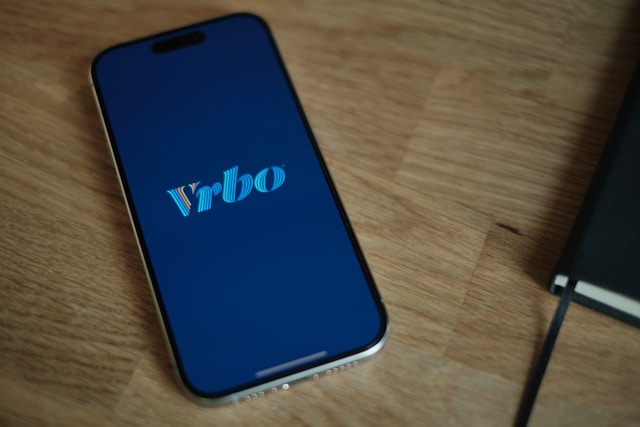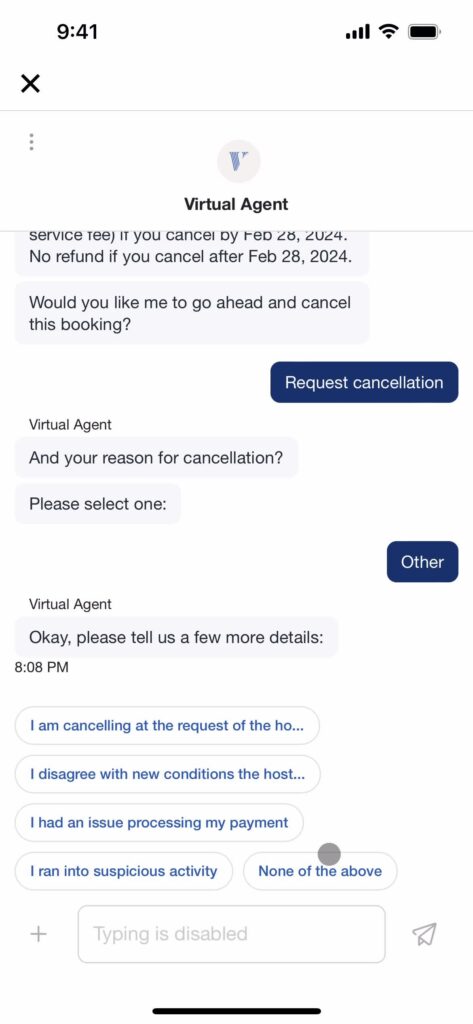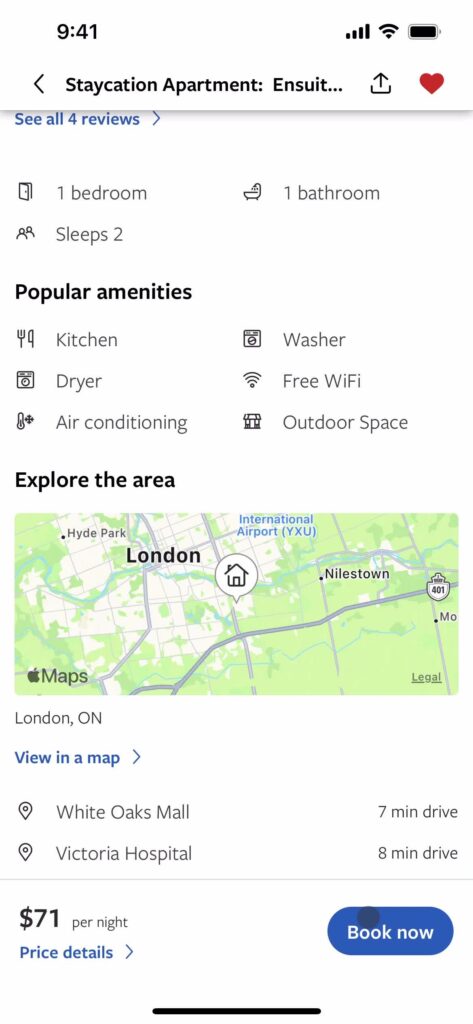Booking a vacation rental can feel complicated, but booking platforms like VRBO can offer a more seamless and intuitive experience. Whether designing for a guest planning a getaway or a property manager optimizing their listings, mastering the booking process is key to success.
In this article, I’ll explain the key steps of the VRBO booking process and explore VRBO’s booking user interface (UI) and user experience (UX). By examining how these elements simplify navigation and decision-making, you can learn how to make the most of VRBO.

How To Book on VRBO Step-by-Step
Direct booking on VRBO is designed to be intuitive and straightforward, guiding users through each step. You begin the process by entering a destination, travel dates, and the number of guests. Features like auto-suggestions and a built-in date picker help to refine the search.
However, VRBO could improve its differentiation of location names (e.g., cities vs. regions), enhancing navigation. Custom icons or better information architecture could also make navigation on the platform more efficient.
After clicking “Search,” users can filter results by amenities, property types, and price ranges. A map view further aids in visualization, helping users quickly narrow down options for a more personalized experience.
Selecting a property opens a new page with more detailed information about the listing. These details can help improve user satisfaction by reducing frustration and abandonment. A prominent “Request to book” (or “Book now” for listings with Instant Booking) button on both desktop and mobile ensures the process remains relatively straightforward.
After selecting a property, users proceed through a three-step booking process: “Begin your booking,” “Review rules & policies,” and “Choose your payment method.” The process is guided by helpful visuals and reinforced with clear “Agree & Continue” calls to action (CTAs).
While VRBO’s booking flow is smooth overall and offers a good user experience, small design and functionality adjustments could enhance usability. These changes would make the experience more intuitive for both guests and property managers and could be helpful to consider in your own designs.

How To Cancel VRBO Booking: Best Practices
Clear communication and transparency are key to a positive cancellation experience. By making the process intuitive and quick, you can reduce friction and prevent frustration for both guests and hosts.
Guests can cancel a booking by going to the “Trips” section of their VRBO account, selecting the reservation, and clicking “Change or cancel.” As shown above, VRBO’s Virtual Assistant will then guide you through the cancellation process. Effective chatbot UI like this can be essential for guiding users, but tricky for designers to get right.
Cancellation policies are displayed when booking and again during the cancellation process, ensuring users are aware of any fees or penalties. This transparency helps set expectations and minimize frustration.
Hosts can cancel bookings through their Owner Dashboard by selecting the “Cancel” option on the reservation details page. Clear communication is essential—well-communicated cancellations can help preserve a host’s reputation and the guest’s experience.
Focusing on these best practices can ensure a smooth process for both guests and hosts. Best practices for cancellation include:
- Clear policies: Prominently displaying cancellation policies helps set clear expectations for guests, reducing misunderstandings and frustration. Make sure policies are easy for guests to find both before and after booking.
- Transparency: Being upfront about fees, penalties, or available alternatives ensures guests understand the consequences of canceling. Clear communication of these elements fosters trust, encouraging guests to make informed and timely decisions, which can also benefit hosts.
- Effective communication: Maintaining clear communication between guests and property managers is essential for managing expectations. Whether confirming cancellations or offering alternatives, timely communication helps maintain positive impressions and prevent misunderstandings.
By focusing on clarity, ease of navigation, and transparent communication, the cancellation process can be seamless and efficient for both guests and property managers.

How To Set Instant Booking on VRBO To Optimize the Booking Process
Enabling Instant Booking is one of the most effective ways for property managers to streamline the booking process on VRBO. This feature lets guests reserve a property immediately without waiting for host approval. Reducing booking delays can increase conversion rates and improve overall efficiency.
As shown above, a “Book now” button appears on the listing page as well as later in the booking process. In contrast, listings without Instant Booking display “Request to book” instead.
While seemingly minor, copy like this can be essential for providing clear affordances and guiding users smoothly through the process. Maintaining consistency in the language and flow helps reinforce user expectations and make the experience more intuitive.
To set up Instant Booking, hosts can navigate to the property’s listing page via the Owner Dashboard. From there, select “Rules and Policies” under “Property”, then click on the “Booking Type” tab. This tab can feel a bit hidden as it doesn’t follow UI conventions for making clickable elements recognizable.
Once on the “Booking Type” tab, hosts can choose between Instant Booking and “24-hour Review.” VRBO tags Instant Booking as “Recommended,” including additional information on its benefits and a link to learn more.
Instant Booking reduces friction in the booking flow by eliminating delays. This efficiency is especially valuable in a competitive market where guests may abandon bookings if they have to wait for approval. By enabling Instant Booking, property managers can optimize their booking flow, increase efficiency, and offer guests a seamless experience.
Property managers can further optimize the booking process for guests by ensuring their listings have clear and accurate descriptions. This reduces the risk of disputes or cancellations by helping guests better understand the property before booking.

How To Turn Off Instant Booking on VRBO
For property managers who prefer more control over bookings, turning off Instant Booking allows them to review prospective guest profiles first. This ensures that specific conditions, such as guest reviews or minimum stays, are met before confirming reservations.
VRBO also provides instructions on changing your booking type on its website, but as a quick recap, here’s how to do it:
- Log in to your VRBO account and navigate to your Owner Dashboard.
- Select the property you wish to modify.
- In the Rules and Policies section, go to the Booking Type tab.
- Select the 24-hour Review option.
Once disabled, future bookings will require manual approval. Hosts can then screen guests to ensure they meet all booking criteria. While this offers hosts more control, it can also lead to delays, potentially causing guests to book elsewhere if the confirmation takes too long.
Designers must consider this trade-off between control and convenience, as it impacts both host satisfaction and guest experience. Instant Booking reduces friction for guests by eliminating delays, while 24-hour Review allows hosts more control over who books their property.
A well-designed UX helps hosts make informed decisions by understanding these trade-offs. Clear communication between hosts and guests remains essential for them to manage expectations and ensure a smooth process regardless of booking method.

Designing Seamless Booking Experiences With Page Flows
As we explored with VRBO booking in this article, a smooth booking flow can enhance user satisfaction and reduce drop-offs. Whether you’re designing for a guest or property manager, an intuitive system creates a seamless experience and can result in higher conversions.
For additional design inspiration, tools like Page Flows offer insights into current design trends and provide real-world examples to optimize your platform’s user experience. Get started today to gain on-demand access to successful user flows from industry leaders.
FAQs
How does payment work on VRBO?
Whether you’re booking immediately or requesting to book, you enter your payment information at checkout. Guests can pay securely via VRBO using a credit card or over time with Affirm. The payment method is selected during the booking process, as discussed above.
After the booking is confirmed, hosts can choose to receive payments via direct deposit or check. All transactions are processed securely through VRBO’s platform, ensuring protection for both guests and hosts.
Can you book on VRBO without an account?
While you can browse listings without an account, booking a vacation rental on VRBO requires creating an account. This helps users keep track of upcoming reservations, payments, and communications while improving security and enabling a more personalized experience.
How can I contact VRBO customer service?
VRBO’s Help Center provides information on how to contact customer service. Support options include chat, phone, and email. Be ready with your booking details and account information in order to resolve issues quickly.
Is there a VRBO booking app?
Yes, VRBO has an app optimized for mobile-first interactions, offering quick access and easy browsing. In contrast, the website provides a more feature-rich interface for desktop users, with a broader view of properties and booking details.
While both platforms offer a seamless experience, the app is ideal for quick, on-the-go bookings, while the website is better suited for detailed exploration and managing more complex tasks. Choose the platform that best suits your needs.




